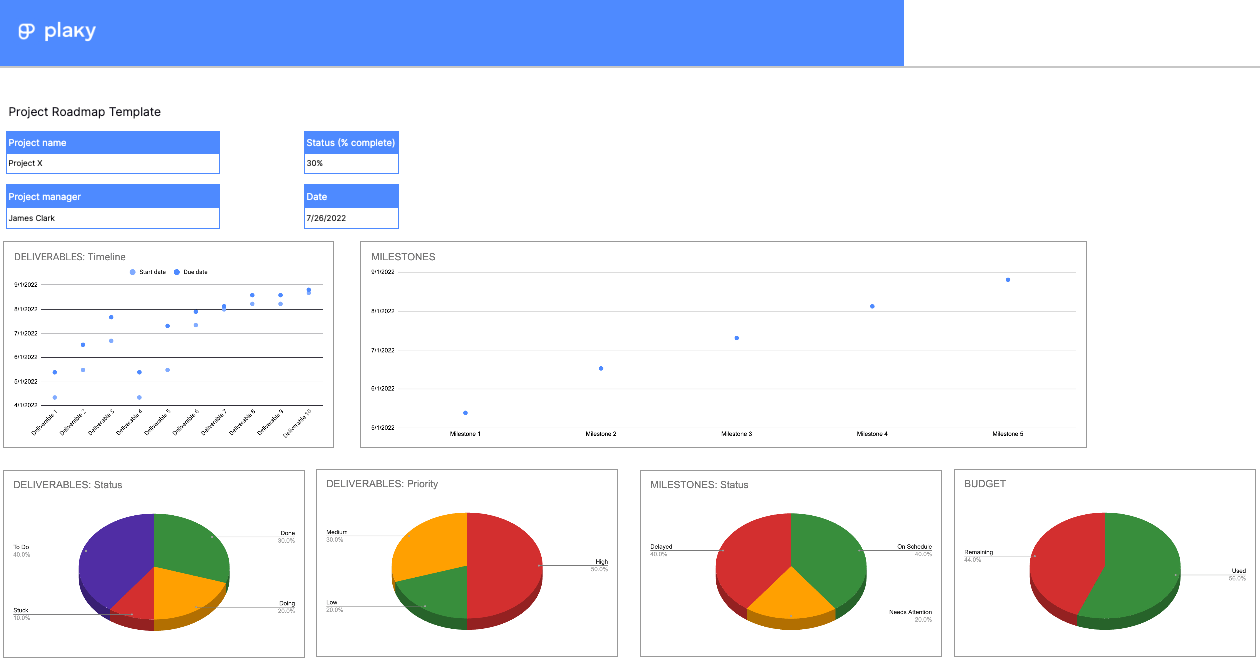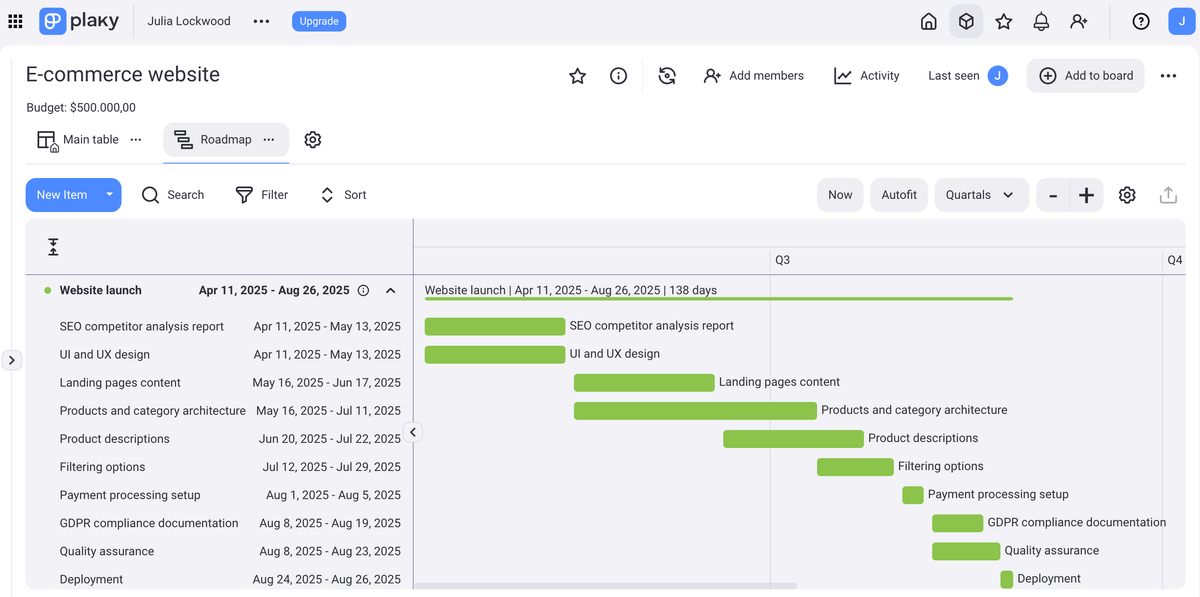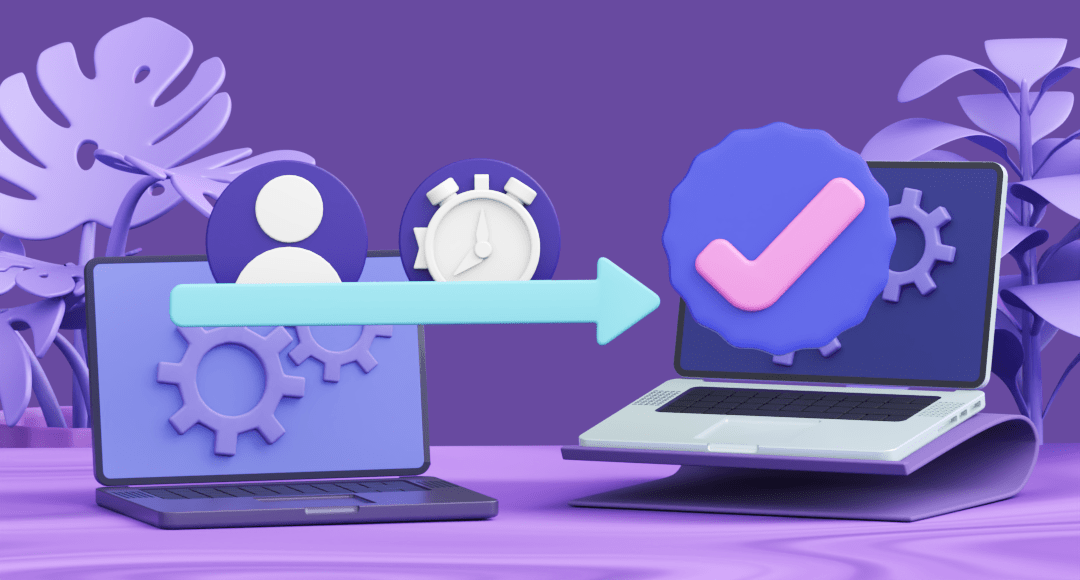Project Roadmap: What Is It & How to Create It (+ Template)
How do you present the schedule of an upcoming project without going into too much detail? Try project roadmapping.
Before project development starts, stakeholders need to see a high-level overview of the project manager’s plan. There’s no better way to present the project roadmap than to create a visual outline of the planned work.
This endeavor gets even easier when you have a premade template at hand and a tool that helps you track the project’s progress all the way to successful completion.

- A project roadmap visually depicts a project’s goals, milestones, and deliverables.
- Project roadmaps are mainly created for external use, while project plans are mostly used internally.
- A project roadmap should include project goals, milestones, deliverables, task dependencies, risks, resources, and timelines.
- The roadmap should be updated regularly throughout project development.
- You can use project management tools and templates to create an efficient project roadmap.
Table of Contents
What is a roadmap in project management?
A project roadmap is a timeline of the project’s objectives, milestones, and deliverables.
Project managers create the project roadmap, outlining the possible risks, dependencies between activities, and necessary resources.
The project roadmap is created before the project starts, but it’s used as a guide throughout the project’s life cycle to make sure it stays on track.
Project roadmap vs. project plan
The project roadmap and the project plan are both vital documents created before any work on the project starts. However, they are 2 separate documents that each serve a different purpose.
A project roadmap offers a high-level overview of the project’s phases and steps. It’s mostly created for stakeholders who can get an idea of the project’s timeline by merely looking at it. When the project is underway, project managers can also present its progress by pinpointing the current state on the roadmap.
In contrast, a project plan is a document that also outlines the project timeline but in much more detail. Unlike the project roadmap, it’s mostly designed to be an internal tool for team members and their managers.
Project plans include detailed information about:
- The project scope,
- The approved budget and cost management,
- Resource management,
- The timeline and schedule,
- Tasks, responsibilities, and deadlines, and
- Risk management.
Why do you need a project roadmap?
The 3 main reasons every project manager needs a project roadmap are:
- Proper task prioritization,
- Better communication with stakeholders throughout the planning process, and
- Early risk detection.
Once the project development starts, it becomes more challenging to keep the focus on important milestones. However, having a set project roadmap helps teams stay on track and check at any point in time what they should focus on. This way, no resources or time are wasted in vain.
Meetings and check-ins with stakeholders should also be held on a regular basis to update them on the project’s progress. During these meetings, project managers usually present what the team has done so far, without getting into too much detail. That’s when the project roadmap comes in handy as it provides a clear overview of objectives and whether they’ve been accomplished.
Finally, remember that according to recent project management statistics, ignoring red flags is one of the reasons projects fail, so managers should pay close attention to the early signs of failure. Luckily, when the progress made is compared to the roadmap’s timeline, project managers can easily see if there’s a risk some deliverables won’t be ready on time or if the project is going off the rails.
What should a project roadmap include?
A project roadmap should contain the following elements:
- Project goals — clearly outline the objectives of the project,
- Milestones — break down the project into phases and set regular milestones that must be achieved at certain points during project development,
- Deliverables — define what needs to be delivered in a concise way,
- Project timeline — place all the project phases and activities on a timeline so that the project team and stakeholders know what needs to be finished and when,
- Task dependencies — highlight the dependencies between connected activities so that everyone will know at a glance if their assignments depend on the timely delivery of others and vice versa,
- Resources — allocate the budget and people efforts necessary to complete the project, and
- Risks — write down the project risks and how to mitigate them.
How to create a project roadmap
Creating a roadmap in project management is rather easy when you know exactly what it must include. We’ve listed the necessary steps to creating a project roadmap below.
1. Define project objectives
The project roadmap is a guide, meaning it should be short and to the point. Therefore, the defined project high-level goals and objectives should be realistic and concise.
For example:
“Deliver a 5-minute video on the newest software features by December 23.”
The details will then be incorporated into documents such as the project charter and the project plan.
2. Identify milestones and deliverables
Break down the project into phases and set a milestone for each. This will make it easier for the project team, product owners, and stakeholders to know exactly which chunks are completed and how much more there is to go.
Each project phase can then be further split into action items and specific deliverables. But remember there’s no need to go into great detail — a simple list will do.
💡 Plaky Pro Tip
If you want to learn more about deliverables in project management, check out our guide:
3. Define dependencies
Dependencies are relationships between project activities. Some tasks simply can’t start before others are completed, like filming scenes and then editing them to create a video.
Sequencing activities will help you visualize the project schedule and workflow so that you can identify bottlenecks before they happen.
💡 Plaky Pro Tip
Want to go more in-depth about dependencies in project management? Read our guide:
4. Estimate time and resources
Once you define milestones and deliverables, you can start estimating the time and resources necessary to achieve them. This means realistically evaluating the number of hours or days for each activity, the costs of required materials, and employee compensation.
There’s no need to be surgically precise, but these evaluations will also be useful for other more detailed documents.
When making your estimates, make sure to leave enough space for the tasks to be completed without overly rushing the team — but don’t stretch out the deadlines too much to avoid disappointing stakeholders.
5. Outline the project timeline
Place the defined milestones and deliverables on a project timeline so that the stakeholders can be informed of its duration.
This step should be fairly easy if you’ve already defined the activities, their relationships, and their duration. All that’s left to do is put them on a calendar so that everyone involved can get an accurate idea of the project timeline.
💡 Plaky Pro Tip
Try one of our free project timeline templates that come in various formats, depending on your needs:
6. Identify potential risks
Including potential risks in the roadmap can help you keep a close eye on them and step in with predefined mitigation strategies as soon as the first red flags show up.
Some of the obstacles to successful project completion can be related to:
- Resources,
- Task dependencies,
- Team members, or
- Other internal or external factors.
💡 Plaky Pro Tip
Find out more about risks in project management in our guide:
7. Present the project roadmap visually
Create a visual representation of the project roadmap so that it’s easier to understand and follow.
There are a few ways to illustrate the roadmap, including using a project roadmap template and creating a Gantt chart in project management software.
That said, having a template will save you plenty of time and provide a uniform look for all your projects.
You can use premade, ready-to-use project roadmap templates for free and adjust them to your needs. Here’s a Plaky template that you can download right away and create your project roadmap:

Alternatively, project management software like Plaky can help you organize your activities and visually present a roadmap in a Gantt chart. Tracking activities, collaborating with your team, and displaying the project roadmap as a timeline using only one tool is a very efficient way to manage your projects.
💡 Plaky Pro Tip
If you want to find out more about the options you have in Plaky, check out the following pages:
8. Review and update your roadmap
The project roadmap is not a static document — it constantly changes as the project develops.
The primary purpose of the roadmap is to serve as a guide, but the longer it takes to complete a project, the more likely it is that unforeseen circumstances will happen.
Therefore, the project roadmap should be constantly reviewed and updated to reflect the changes that impact the project.
Tips for creating a project roadmap
Creating a project roadmap can be challenging, especially for inexperienced project managers. Here are a few tips on how to deliver a good project roadmap:
- Keep information short, clear, and concise — a roadmap should provide an overview of the projects, so make sure all important information is provided at a glance.
- Don’t go into detail about project activities — a project plan will give a detailed description of each activity while a roadmap only needs to display an outline of the project.
- Define assignment responsibilities — stating whose responsibility it is to deliver certain results makes each team role clear immediately and reveals right away whether someone will have too much on their plate.
- Set realistic deadlines — the stakeholders may be impatient to see the project finished as soon as possible, but you must also pay attention to the quality of the results and give the team enough time to complete their tasks.
- Involve the project team members and stakeholders when defining milestones and estimates — no matter how seasoned project managers are, it’s better to check with those who are actually performing the tasks whether the timeline has been estimated correctly.
- Use software that facilitates communication and collaboration — using whiteboards, phones, and spreadsheets can do more damage than good as information gets easily scattered.
- Make sure to check and update the roadmap regularly — projects need to adapt to unforeseen circumstances and these changes should be reflected on the roadmap at all times.
Project roadmap example
We can use a project roadmap for various types of projects, including the following:
- IT,
- Marketing,
- Sales,
- Business development, etc.
Let’s show how it works in an example.
Suppose you have a physical store and want to develop an E-commerce website to help you expand your sales.
The project roadmap may look like this:
| Project roadmap element | Description |
|---|---|
| Objectives | – Increase people’s awareness of the business – Support sales by increasing the number of monthly qualified leads by 20% – Increase monthly sales by 25% |
| Deliverables and timeline | – SEO competitor analysis report: April 11 – May 13 – Landing pages content: May 16 – June 17 – Product descriptions: June 20 – July 22 – UI and UX design: April 11 – May 13 – Products and category architecture: May 16 – July 11 – Filtering options: July 12 – July 29 – Payment processing setup: August 1 – August 5 – GDPR compliance documentation: August 8 – August 19 – Quality assurance August 8 – August 23 – Deployment August 24 – August 26 |
| Milestones | – Design ready: May 13 – SEO analysis and content preparation completed: May 13 – Basic functionalities developed: July 11 – Filtering and payment options integrated: July 29 – Data entry completed: July 29 – Payment processing setup completed: August 5 – The Consent Management Platform (CMP) integrated: August 19 – QA finished: August 23 – Deployment finished: August 26 – Website launched: August 29 |
| Risks | – Underestimated time/resources – Problems integrating 3rd-party systems such as payment options and chat support – Cross-platform compatibility |
| Resources | Design team: 2 members Marketing team: 2 members Development team: 3 members QA team: 2 members Budget: $500,000 |
| Dependencies | – SEO analysis and content preparation are completed before data entry – Basic functionalities and advanced filtering are developed before data entry – Payment processing setup is done before GDPR implementation – The Consent Management Platform (CMP) is implemented before the website launch – Website testing is done before the launch |
Creating a project roadmap with Plaky
And yet — a list like the one above doesn’t say much and it definitely doesn’t show clearly the project timeline.
Instead, you can use project roadmap software like Plaky to create and keep your project roadmap up-to-date.
Here’s what the timeline of the project we described would look like in Plaky:

These are the steps to take when creating a project roadmap in Plaky:
- Add a new board,
- Add custom fields with the values you need for your project,
- Create items and add details like assignee, status, start and end date OR timeline, and
- Use the Gantt view to visualize the roadmap as a timeline.
In only 4 steps, you’ll have a project roadmap ready to show your stakeholders and use as a guide. Plus, not only will you be able to visualize the roadmap as a timeline, but you’ll also be able to expand each activity with details that will help you lead the project to its successful completion.
And that’s just the tip of the iceberg. Plaky is a powerful project management tool that lets you track progress, communicate with the team in real time through comments, and share files — all in one place!
Start building your roadmap and tracking your projects with Plaky today by starting a free 14-day trial and giving all its features a spin.
 Project Management Hub
Project Management Hub 











